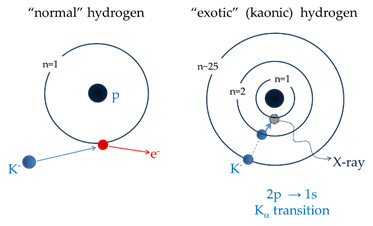QCD with light quarks

Kaonic Atoms
Precision X-ray spectroscopy of kaonic atoms represents an excellent tool to study the chiral symmetry breaking scenario involving a strange quark. Kaonic atoms are QED bound systems in which the heavier, negatively charged particle replaces an electron, for example a kaonic hydrogen (K-p) atom could be formed. In general, studies of exotic mesonic atoms have provided important information on strong interaction (hadron) physics.
Effective field theories (EFTs) provide a crucial framework for analysing the properties and interactions of hadrons and nuclei. These theories describe low-energy hadron physics implementing the symmetries of the underlying theory, QCD, using effective Lagrangians for the relevant degrees of freedom, which leads to observable effects in the spectrum of exotic hadronic atoms. [Read more...]
Hadronic Systems with Strangeness
Strangeness hadron physics tries to reveal the complex dynamics and phenomena of quarks and gluons, e.g. hadron properties in nuclear medium, symmetry breaking pattern and hadron mass generation, new forms of hadrons.
While for short distances (high energy) the "strong" QCD interaction is characterised by colour confinement and asymptotic freedom, the interaction becomes weak and can be treated perturbatively. On the contrary, at long distances (at the temperature of the present Universe) the interaction stays strong and colour charges are confined. The chiral symmetry and the heavy quark symmetry play a role in the QCD at the light quark sector (mu, md << ΛQCD) and at the heavy quark sector (mc, mb, mt >>ΛQCD), respectively. At the energy scale of the strange quark mass (≈ΛQCD), however, neither of the symmetries is good enough and the dynamics of the strange quark is thus very sensitive to the dynamics of QCD. [Read more...]